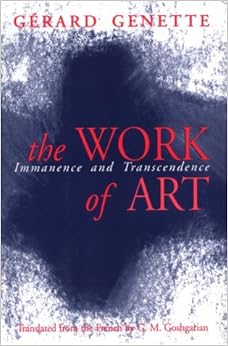Gérard Genette on What Art Is

The Work of Art reminded me that Genette’s interests uncannily intersect with mine: narrative theory (Narrative Discourse, Narrative Discourse Revisited), parody (Palimpsests), and the trappings of the printed page (Paratexts). So his turn to textual ontology—what is a work of literature?—comes as no surprise. Actually, he’s well disposed to bring philosophical approaches to ontology into conversation with literary considerations, informed somewhat by an attention to the concerns of textual scholars that comes out of his investigation of paratexts. I love the convergence of all three streams, which I attempted to unite in my article “The Design of Fiction and the Fiction of Design.” Textual ontology is also important to my ongoing work on the short story cycle when dealing with multiple versions of a story in various publication contexts. (What is the ideal work if a story appears in different forms directed at more than one audience?) It even cropped up last semester when teaching a course on conceptual writing, too. Appropriation art and procedural work challenge the traditional ontologies of the work of art. (If I transcribe a radio broadcast and publish it as literature, what is the status of the text I created and had reproduced?)
With that last example in mind, the section of The Work of Art that was most compelling so far explored autographic art that results in multiple products (cast sculpture, printmaking, and tapestry-making). A mold, for instance, is a singular artistic production that allows one to create identical cast sculptures. This is not the same as a text existing in many copies, since the authorial production of a literary work would not have the same material self-sufficiency as the mold. The work of literature is instead ideal (allographic), made of language rather than material, and not coeval with its material forms (i.e., the printed page). But in the case of appropriation literature, cast sculpture might be a fitting metaphor. Take the texts of Kenneth Goldsmith’s Seven American Deaths and Disasters where radio and television broadcasts are written out and presented as literature. Goldsmith is not copying an ideal text but the actual language recorded. Sure, the transcriptions rely on what he hears, but he is trying to hear (and render) what was said, not what was meant. The radio broadcast of the Challenger explosion, in this way, is like what shapes the mold for a cast sculpture (the resulting text representing an ideal work). There would be some that might debate the ideality of that production: those for whom Seven American Deaths and Disasters is not literature but in fact non-fiction. How is a text literature just because someone says so?, they might protest. But maybe the cast sculpture comparison allows us to reply, how can it be otherwise? The cast sculpture requires the mold to exist, and the existence of the cast supersedes the mold.
Genette, in setting the boundaries of his study, claims that “a work of art is an intentional aesthetic object” or, put another way, “an artifact (or human product) with an aesthetic function.” Goldsmith’s appropriation literature clearly meets the first condition but perhaps not the second (just what is an aesthetic function?), calling into question the equivalence of the two definitions. I understand that Genette introduces the idea of function to distinguish aesthetic objects from natural ones or from tools. He must be aware that aesthetics and functionality have commonly been opposed to one another. But the value of this odd conjunction is to separate physicality from functionality. Duchamp’s readymades don’t change physically when displayed in a gallery; the object changes its function, though, Genette notes. I find that a clear and important distinction while still being skeptical about his deployment of function (the word and concept) here. His later point that the existence of the work of art is “extrafunctional” (what it is is more than what it does) makes sense and is strange, because isn’t the aesthetic function is precisely to transcend (functionality and physicality)? I hope that my confusion will dissipate with the arguments to come in the book, and if not, I can revisit these statements to decide whether to speak of function in this way is more trouble than it’s worth.
No comments yet.
Add your comment